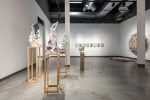This year the traffic in Miami defeated me. The amount of activity generated by more than twenty art fairs would benefit from public, and preferably underground, transportation. While I saw plenty of art over two days at three fairs, I saw nothing sufficiently new or challenging to make up for bumper-to-bumper traffic and streets, endlessly clogged, with drivers who didn’t know where they were going. After three fairs, I gave up. So this won’t pretend to be a best of the best, or even an overview.
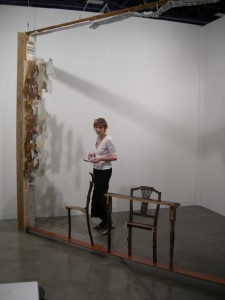
I spent the first afternoon at Art Basel Miami Beach with my friend, neighbor and Rutgers colleague, Margery Amdur (whose work was on view at Projects gallery at the Aqua fair). To the extent that we noticed a theme, it was architecture. That’s Margery, above, at Galeria Casas Riegner,where Leyla Cardenas had made what looked like a thin, front-to-back slice of a room, inspired by an 1880s house that was being torn down as part of Bogotas’s urban renewal. Cardenas retained evidence of generations of wall-paper (which she pulled apart and threaded on strings, parallel to the wall), as well as profiles of occasional pieces of furniture. It was a phantom of suppressed memory.
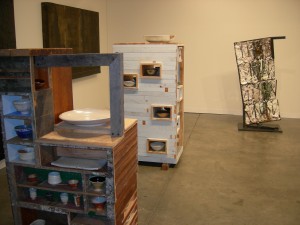
Theaster Gates showed sections of an old house at Kavi Gupta Gallery, Chicago. If not the same house, it was similar to the one he re—installed within the nineteenth-century Heugenot House in Documenta 13, this summer (which I wrote about on Aug. 5, 2012), although these fragments worked well as free-standing, independent pieces.
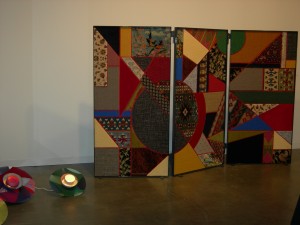
An Istanbul gallery, Rampa, displayed a large folding screen as well as lights by Nevin Aladag. On close viewing it became apparent that their quilt-like patterns were actually collages of the lowliest, machine-made, Turkish-style carpets. I don’t know any specifics, but suspect there is a social commentary to their use in this context. We saw another screen nearby, at Nara Roesler, one of a large number of galleries from Brazil this year. The patterned and pierced sections of Lucia Koch’s piece could be manipulated by viewers.
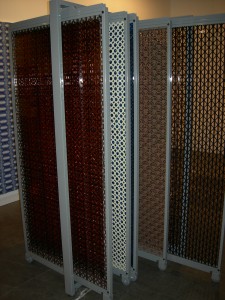
Across the street from Art Basel Miami Beach, Design Miami commissioned one of the more spectacular and successiful pieces I saw: a porch in front of the exhibition space by Snarkitecture. Called Drift, it was constructed of what looked like endless boxers’ heavy bags, made of white tenting plastic and suspended improbably above the visitors lounging on grey, snaking benches.
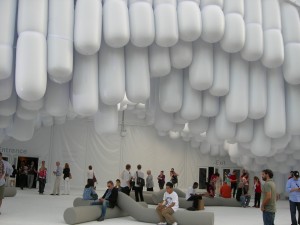
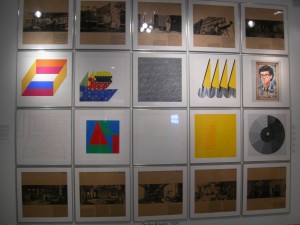
At Art Miami, one of the more striking works was only shown in partial form at Westwood Gallery, NYC: a wall of art and documentation called On the Bowery, produced between 1964-1971. The portfolio consists of an original silkscreen by each of ten artists (including Twombly, Ryman, Robert Indiana and others), a photographic portrait of each artist by Eliot Elisofon, text, and views of their gritty, studio surroundings – long before the area was gentrified by the New Museum. It forms a good snapshot of one group of New York artists of the period, and would be a perfect exhibition for a small university gallery.
And, a stunning cityscape by Arden Bendler Browning was attracting a lot of attention at Bridgette Mayer Gallery, Philadelphia.
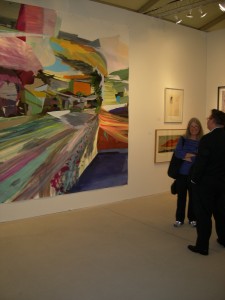
Artists have to vent their feelings and some, at least, do it with style, such as Alex Gingrow’s wall of drawings which explore the question of how a young artist can succeed in the art world, created in the form of much-enlarged labels – of the sort that identify art in transit, and accumulate on the reverses of popular artworks (to the benefit of dealers and art historians). Only these tell a humorous and cynical story.
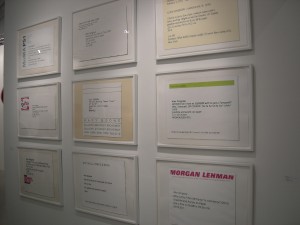
The work that really stopped me was at D.C. Moore, New York , in the new fair, Miami Project. Whitfield Lovell’s Pago Pago (2008) was given both the space and centrality it deserved. It’s a stunning recollection of a WWII soldier (drawn in pencil on a panel) who is listening to music, produced by actual radios, of Billie Holliday. It is a bittersweet image of an African American soldier, fighting for a country where he was still a second class citizen.






